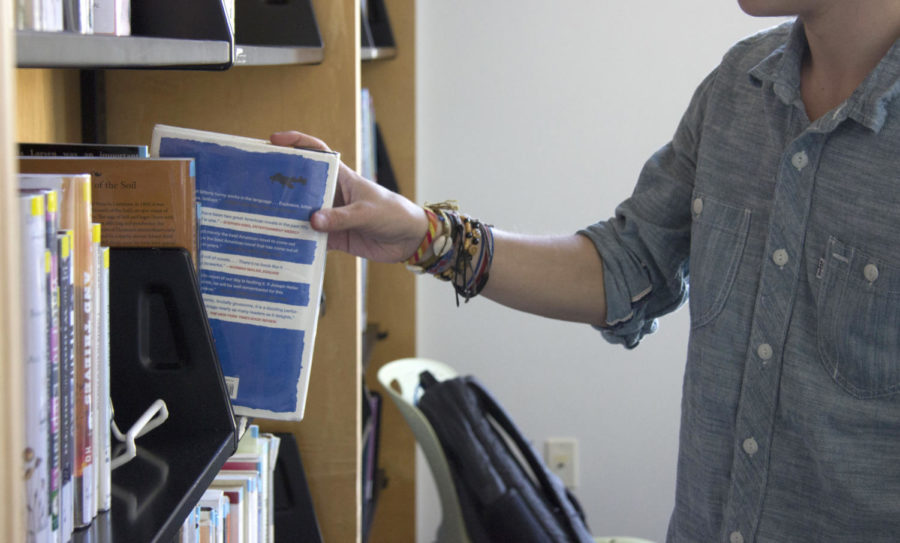English department pulls two Junot Díaz stories from sophomore curriculum six months after sexual misconduct allegations
Unknown individual placing book back on shelf of Alexandria library. By Phoebe Grandi, Visuals Editor
Nearly seven months after multiple sexual misconduct allegations came out against him, two of author Junot Díaz’s short stories, “Drown” and “How to Date a Brown Girl (Black Girl, White Girl, or Halfie),” have been taken out of the winter English 2A curriculum, but why?
In May of 2018, author Zinzi Clemmons accused Díaz of sexual assault both at the Sydney Writers’ Festival and over Twitter. Clemmons claimed that Díaz forcibly kissed her during a writing workshop she invited him to in 2012. More women, including authors Monica Byrne and Carmen Maria Machado, have accused Díaz of sexual misconduct and public displays of misogyny since then. The majority of allegations came out after Díaz published the short autobiographical memoir, “The Silence: The Legacy of Childhood Trauma,” in the New Yorker this past April, which detailed his own experience with sexual assault as a child. According to a message she tweeted in May, Clemmons believes that this story was an attempt to pre-empt allegations against him.
These allegations complicated how Urban students understood the content of Díaz’s short stories, given that the two previously offered in the curriculum deal with themes surrounding sexual assault. Cathleen Sheehan, who taught English 2A in the fall, said that “a student in my class had looked up information about Junot Díaz and had heard that he was accused of sexual harassment. Then, because of that, [this student] interpreted one of the short stories, [“How to Date a Brown Girl (Black Girl, White Girl, or Halfie),”] as a story about sexual assault. That was where it really kind of concerned me as a teacher, that it really was difficult for the student to come to Junot Díaz’s writing without looking at it through that lens because of what they had discovered.”
Courtney Rein, English Department Chair, spoke to the important themes this particular short story, “How to Date a Brown Girl (Black Girl, White Girl, or Halfie),” has the potential to offer students. “What we have historically loved about teaching that Junot Díaz story,” Rein said, “has been that when students are getting the most rich, deep, and engaged conversation with it, it makes them look at toxic masculinity [and] makes them look at internalized racism. It makes them look at how women’s mistreatment can often be a byproduct of racism and other forms of systemic oppression.”
But, like Sheehan, Rein emphasized the importance of properly understanding the content of the story, specifically during in-class discussions. “If that story isn’t taught well,” Rein said, “or if the discussion does not go in the most rich direction, then we could be in trouble because a simplistic reading of that story looks like it is merely a teenage boy trying to figure out how to exploit girls in his class. The burden is on the teacher and the students together working to find what is the meaning, and what is the truth of the story.”
Sheehan’s response to the effect of Díaz’s allegations on her students’ understanding of his work echoed Rein’s emphasis on class discussions. “We really just, in that class, started talking, having this discussion of ‘how can you separate the author from the work; when is it difficult to do that; should we be doing that?’” Sheehan said.
Even though Díaz’s work has been taken out of the Winter English 2A curriculum, it has not left Urban’s English classes altogether, and is still being taught in the Modern American Literature class. His book, The Brief Wondrous Life of Oscar Wao, is, as Rein said, “one of the most popular novels we’ve ever taught with students.”
Ratna Kamath, who taught Modern American Literature last spring, said that “his style has so much to offer in terms of a different way to approach the material, but then also different content than what we are hitting. Keeping it in the curriculum is a means of broadening our horizons around both history and the way one can write.”
But as the allegations were coming out in May, Kamath said, “my Modern American Literature class] did a whole thing where we read both his New Yorker article, in which he talks about the cycle of trauma and abuse and what he suffered as a child, and we looked at Twitter allegations and news stories about what he has done possibly to other people.”
Regarding the importance of these in-class discussions, Kamath said “we’re constantly thinking about how to make things better and increase representation but I think it’s important to keep having these conversations and empower students to speak up about their feelings around this and to inform people of the context of our authors so that they can be greater critical thinkers going forward.”
While, as Rein said, “[The English Department] swaps texts all the time,” the removal of Díaz’s stories is a testimony to how author’s actions in real life can have a profound impact on the way students analyze their work. But, due to the stories’ thought-provoking themes and style, “they might come back next year. You know our curriculum is always changing,” said Rein.












